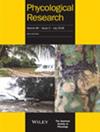日本佐渡岛 Vaucheria piloboloides(Vaucheriales, Xanthophyceae)的生命周期和分子系统发育
IF 1
4区 生物学
Q2 MARINE & FRESHWATER BIOLOGY
引用次数: 0
摘要
摘要虹吸式黄绿色藻类 Vaucheria piloboloides(Vaucheriales, Xanthophyceae)是 Piloboloideae 部分的模式种,在世界各地都有广泛报道。尽管它在分类学上很重要,分布范围也很广,但其详细的生命周期和分子系统发育位置尚不清楚。在本研究中,我们建立了从日本新泻县佐渡岛采集的 V. piloboloides 的培养菌株,并根据 rbcL 序列研究了其形态、生命周期和系统发育位置。样本中配子囊和无性孢子囊的形态及其雌雄同株的特性与大西洋沿岸(包括模式产地)的 V. piloboloides 相似。rbcL 系统进化分析表明,我们的样本与其他 Piloboloideae 物种形成一个支系,支持目前的 Vaucheria 科系方案。在培养条件下,我们的样本表现出单相生命周期。在任何培养条件下都能观察到配子座的发育,而低盐度(盐度 = 24)可诱导无孢子座的发育。本文章由计算机程序翻译,如有差异,请以英文原文为准。
Life cycle and molecular phylogeny of Vaucheria piloboloides (Vaucheriales, Xanthophyceae) from Sado Island, Japan
SUMMARYThe siphonous, yellow–green alga Vaucheria piloboloides (Vaucheriales, Xanthophyceae) is the type species of the section Piloboloideae and is widely reported worldwide. Despite its taxonomic importance and broad range distribution, its detailed life cycle and molecular phylogenetic position are unknown. In the present study, we established culture strains of V. piloboloides collected from Sado Island, Niigata Prefecture, Japan, and examined its morphology, life cycle and phylogenetic position based on rbc L sequences. The morphology of the gametangia and aplanosporangia (asexual sporangia) of our samples, along with their monoecious nature, resembled that of V. piloboloides from the Atlantic coast, including the type locality. The rbc L phylogenetic analysis demonstrated that our sample formed a clade with other Piloboloideae species, supporting the current sectional scheme of Vaucheria . Under culture conditions, our samples exhibited a monophasic life cycle. Development of gametangia was observed in any culture conditions, whereas development of aplanosporangia could be induced by low salinity (salinity = 24).
求助全文
通过发布文献求助,成功后即可免费获取论文全文。
去求助
来源期刊

Phycological Research
生物-海洋与淡水生物学
CiteScore
3.60
自引率
13.30%
发文量
33
审稿时长
>12 weeks
期刊介绍:
Phycological Research is published by the Japanese Society of Phycology and complements the Japanese Journal of Phycology. The Journal publishes international, basic or applied, peer-reviewed research dealing with all aspects of phycology including ecology, taxonomy and phylogeny, evolution, genetics, molecular biology, biochemistry, cell biology, morphology, physiology, new techniques to facilitate the international exchange of results. All articles are peer-reviewed by at least two researchers expert in the filed of the submitted paper. Phycological Research has been credited by the International Association for Plant Taxonomy for the purpose of registration of new non-vascular plant names (including fossils).
 求助内容:
求助内容: 应助结果提醒方式:
应助结果提醒方式:


